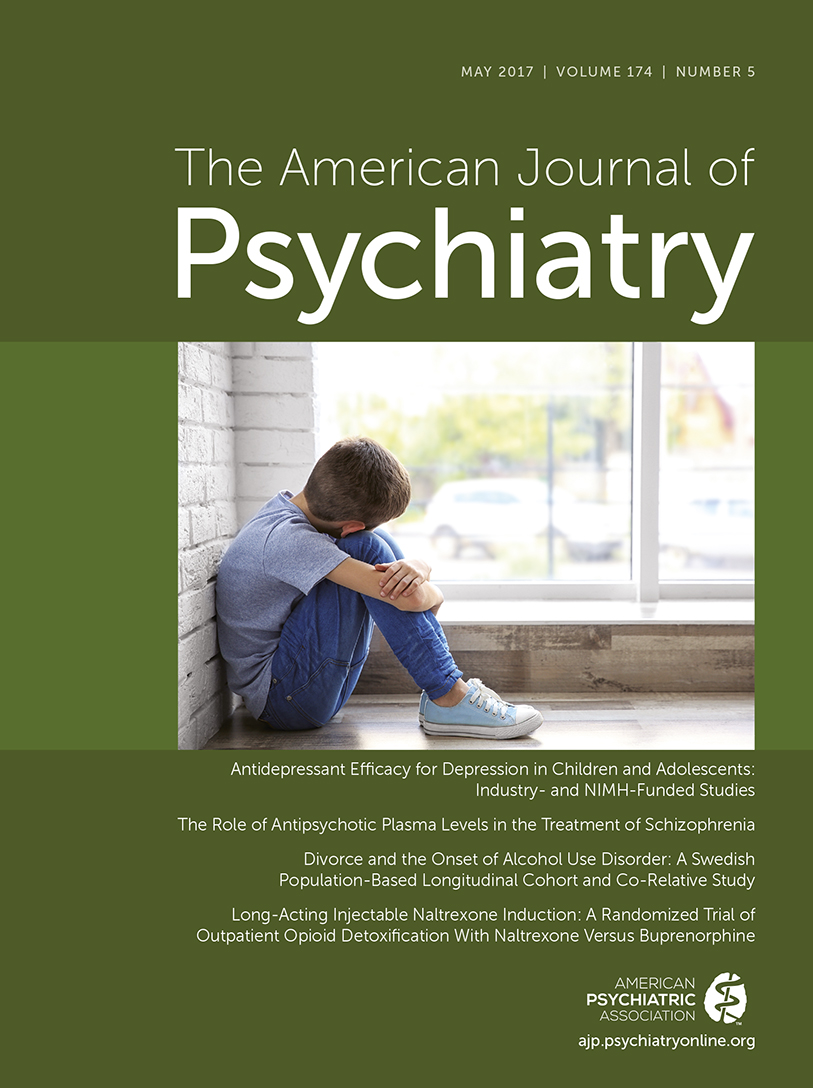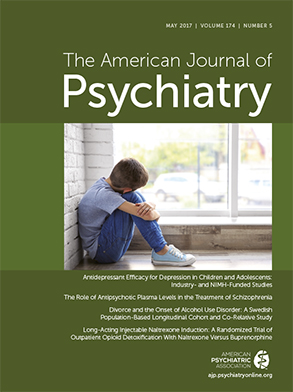Maintenance therapy using methadone, a schedule II opioid, has been a mainstay of outpatient treatment for persons with opioid dependence since the 1960s. Buprenorphine, a schedule III partial opioid agonist, became a second therapy about 20 years later, and its safety profile contributed to approval of the Drug Addiction Treatment Act of 2000, which allows physicians who complete a training course and receive a waiver from the Drug Enforcement Administration to use it for treatment of opioid-addicted patients outside the highly regulated environments of methadone programs. Studies have shown that maintenance on either of these medications reduces opioid use (
1,
2), overdose deaths (
3,
4), and HIV risk behaviors (
5) and improves overall adjustment (
1,
6) and adherence to HIV treatment (
7,
8). The optimal length of treatment has never been determined, except that it should be long-term because substance use disorders are typically chronic and relapsing (
9). Although methadone alone can have meaningful benefits (
10), drug counseling and behavioral treatments often magnify these effects (
11,
12), and the Substance Abuse and Mental Health Services Administration’s treatment guidelines recommend them (
13).
In parallel with the studies of methadone and buprenorphine, others were exploring the treatment potential of naltrexone, an opioid antagonist, and found that a 50-mg oral dose blocked opioid effects for 24 hours, with few side effects (
14). At the same time, there was recognition that patients, even those expressing interest in naltrexone and completing the necessary detoxification in order to receive their first dose, would have adherence problems. This concern led the National Institute on Drug Abuse (NIDA) to fund seven contracts aimed at developing sustained-release formulations, but none were successful (
15).
Early clinical trials using the 50-mg/day dose of naltrexone confirmed the expected adherence problem. For example, of 142 patients taking one dose of naltrexone at the Philadelphia VA Medical Center, 31 took a second dose, and only six took the fourth dose (
16). Other studies found better adherence in patients under legal pressure (
17), and some found that contingency management or involvement of significant others improved adherence somewhat (
18), but the gains were small, and most clinicians lost interest because patient acceptability and outcomes were much better with methadone or buprenorphine, and both could be started without detoxification, a process that was often interrupted when patients dropped out before it was completed (
19).
Interest in naltrexone increased when studies found that it prevented relapse to alcohol dependence (
20,
21), and within a few years an extended-release injectable formulation that provides opioid blockade for a month was developed and approved by the U.S. Food and Drug Administration for alcohol relapse prevention. Around the same time, studies of oral naltrexone in Russia showed significant but modest effects of the oral dose for preventing relapse to opioid addiction (
22,
23). These studies had been relatively easy to conduct, since agonist treatment is against Russian law, patient interest in naltrexone was high, and it was easy to start because detoxification and psychosocial treatment are the standard treatment and the government funds over 25,000 beds with no apparent restrictions on length of stay or readmission. This situation drew the interest of the pharmaceutical company that developed extended-release injectable naltrexone, and that company then conducted the study that led to FDA approval of this treatment for preventing relapse to opioid addiction (
24).
Collectively, these findings added a new treatment option for opioid-addicted patients who are not interested in agonist treatment, who live in areas where agonist maintenance is unavailable or difficult to access, who are prohibited from agonist treatment by probation, parole, or other external pressure, or who have not done well on agonist maintenance and want to try something else. However, outside correctional facilities, where inmates are routinely detoxified, or inpatient programs without strict restrictions on length of stay, outpatient detoxification can be difficult to accomplish (
6).
The Sullivan et al. study reported in this issue of the
Journal (
25) is a step forward in addressing the outpatient detoxification problem. It builds on the work of Mannelli et al., who explored the use of decreasing doses of buprenorphine combined with increasing doses of naltrexone to speed up the transition from addiction to opioid antagonist treatment (
26). As Sullivan et al. point out, relapse during or after detoxification, particularly in the case of opioid dependence, often happens quickly, thus shortening the window for making a transition to naltrexone, which could be an important factor for patients who are interested in naltrexone treatment but do not have access to inpatient detoxification that is of sufficient duration to resolve physiological opioid dependence. In the Sullivan et al. study, two groups started abstinence at baseline and received buprenorphine on day 2. One group then received decreasing doses of buprenorphine over the next 5 days, followed by a delay of 1 week for detoxification before receiving an injection of long-acting naltrexone on day 15; the other group received buprenorphine only on day 2, and then after a washout day received increasing doses of oral naltrexone over 4 days, followed by an injection of long-acting naltrexone on day 8. The low proportion of patients with moderate to severe withdrawal from days 2 to 5, the nonsignificant difference in the proportions of patients who completed detoxification, the absence of significant adverse events in either group, and the finding that 29% of participants in the buprenorphine-alone group relapsed within a week while waiting to start extended-release naltrexone point to the shorter interval after the start of abstention as the mechanism for the difference in primary outcomes between the two groups.
The finding that prescription drug users were more likely than heroin users to transition to naltrexone could be the result of personality or other psychiatric disorders as well as addiction severity, and if replicated may be helpful in patient-treatment matching. Limiting study participants to heroin and prescription drug users raises the question of how applicable the method might be for patients who want to transition from methadone to naltrexone, but that is a topic for another study. Larger questions are what kind of patients choose extended-release injectable naltrexone, how long they continue it, how outcomes compare with agonist treatments, and what proportions start with antagonist treatment and end up in agonist or longer-term residential treatment. These questions will likely be informed by clinical experience and additional studies, including one that NIDA’s Clinical Trials Network recently completed whose results are not yet available (J. Rotrosen, personal communication, 2016). The more immediate question is to confirm these findings in studies using double-blind double-dummy designs, and developing a user-friendly way for clinicians to administer the medications, whose doses change daily. Studies that might provide this information are under way (
ClinicalTrials.gov identifiers: NCT02696434, NCT02537574), and the results could lead to adoption of this method as an option for transitioning from opioid addiction to extended-release naltrexone. If these studies confirm the findings reported here, it is important to keep in mind that although extended-release naltrexone is superior to the buprenorphine taper, half of the patients in the experimental group did not receive their second injection; thus, these findings could represent a first step toward sustained remission but, as with many treatments, there remains plenty of room for improvement.

